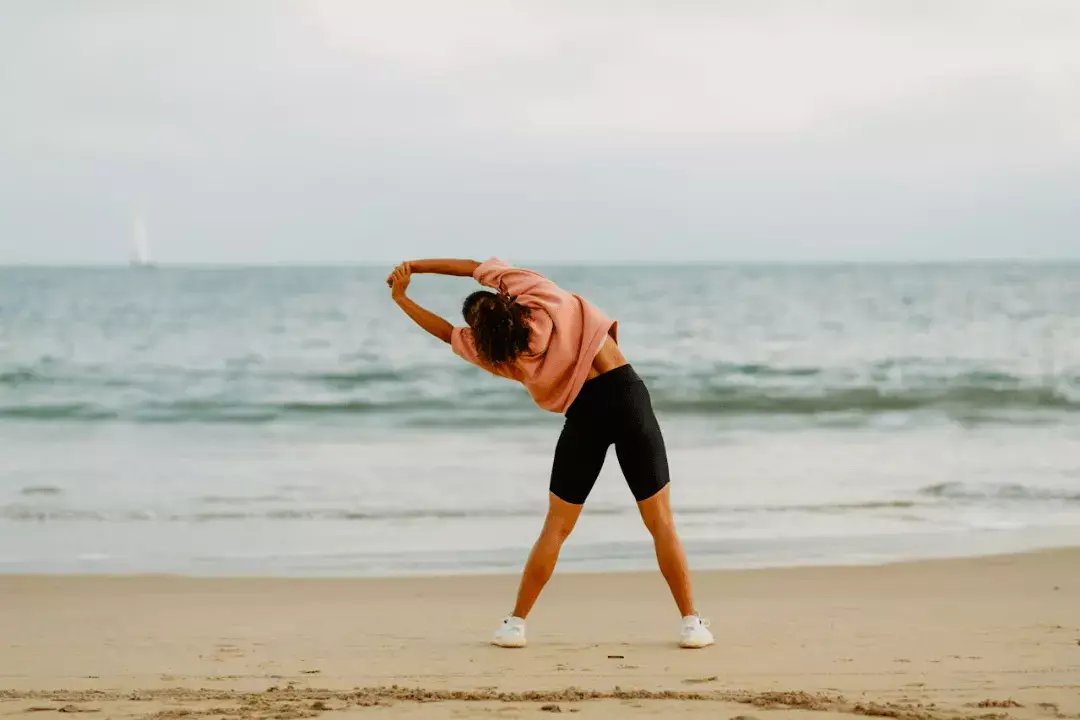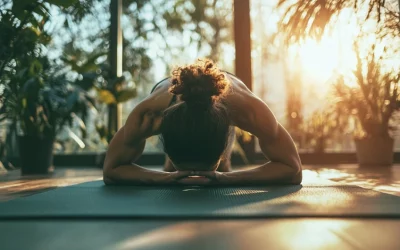Every morning, we’re given a simple choice—start the day with energy or let tiredness dictate our hours ahead. Stretching offers a quick and effective way to set the right tone for the day. It doesn’t require special equipment or much time, making it accessible to anyone. Plus, the benefits go far beyond just feeling more awake.
This article explores the key health advantages of morning stretching, such as improving flexibility, reducing muscle tension, and boosting circulation. Read on and take the first step toward a healthier you!
The Importance of Morning Stretching
Starting your day with morning stretching activates your muscles and joints, helping your body transition smoothly from rest to movement. As you gently stretch, your body wakes up, preparing you for the day ahead. This simple practice not only warms up your muscles but also encourages your mind to become alert, providing better focus and mental clarity for the tasks that await you.
By incorporating stretching into your morning routine, you set a positive tone for the rest of your day. Physically, your body feels more prepared for movement, reducing stiffness and improving your range of motion. Mentally, you begin the day with a calm, focused mindset that can enhance productivity and reduce stress.
Morning stretching is also an excellent way to build a lasting habit that benefits both your physical and mental well-being over time. You can use progress tracking apps like WeStretch to help you maintain this new life-changing routine.
 Benefits of Stretching in the Morning
Benefits of Stretching in the Morning
1. Improved Flexibility and Posture
A morning stretching routine is a superb approach to enhancing flexibility and improving posture. When you stretch in the morning, your muscles gradually lengthen, which improves your overall flexibility over time. This increased flexibility translates into a greater range of motion, allowing you to move more freely and comfortably throughout the day.
As you stretch regularly, you also help to align and strengthen your muscles. Proper muscle alignment plays a key role in improving posture, significantly reducing the amount of strain placed on your spine. By maintaining better posture, you can:
-
Prevent discomfort caused by prolonged sitting or standing.
-
Reduce the risk of developing muscle imbalances.
-
Support healthier movement patterns in daily activities.
2. Reduced Muscle Tension
Gentle stretching can help reduce muscle tension that builds up while you sleep. When you remain still for hours overnight, your muscles can stiffen, leading to that common feeling of tightness upon waking. By incorporating morning stretches into your routine, you can release that tightness, allowing your body to feel more at ease.
Stretching also boosts blood flow to your muscles, which not only reduces stiffness but also promotes relaxation. Increased circulation means your muscles are more oxygenated and nourished, helping them feel less tense and more flexible.
By making stretching a regular part of your morning, you can prevent muscle tension from accumulating throughout the day. This consistency leads to a more relaxed and comfortable body as you move through daily tasks, helping to avoid that all-too-common feeling of tight or sore muscles later on.
3. Enhanced Circulation
Stretching in the morning provides more than just flexibility benefits—it promotes better blood flow throughout your body. When you stretch, you encourage the movement of oxygen-rich blood to your muscles and tissues, helping them function optimally. This can make a significant difference in how you feel throughout the day.
Boosting circulation also plays a key role in delivering essential nutrients to your organs, improving their functionality. With better blood flow, your:
-
Heart pumps more efficiently
-
Lungs receive more oxygen
-
Digestive system operates more smoothly
In addition, enhanced circulation aids in the removal of metabolic waste from your muscles, helping to reduce soreness and stiffness, especially if you sit or stand for long periods during the day.
4. Boosted Energy Levels
Morning stretching is a simple yet effective way to kick-start your day with more energy. Activating your muscles and increasing blood flow through stretching naturally boosts your energy levels, helping you feel more awake and ready to tackle the challenges ahead.
By waking up your body and mind, stretching helps shake off any lingering grogginess, making it easier to transition from sleep to an active, productive day.
The benefits of morning stretching for energy include:
-
Activating muscles to increase blood flow
-
Preparing both body and mind for the day
-
Reducing grogginess by loosening tight muscles
Starting your day with just a few simple stretches is such an easy, natural way to feel more awake. I mean, the moment you get out of bed, it really helps you feel more alert and ready to take on the day.
5. Stress Relief
Stretching releases tension stored in your muscles, which often builds up due to stress. When you go through a simple series of stretches, you may notice that your muscles feel looser, and this physical release can have a direct impact on your mental state. Just as your muscles relax, your mind can also feel less burdened.
To enhance the calming effects, combining your stretches with mindful, deep breathing can be especially beneficial. As you move through each stretch, focus on your breath, inhaling deeply and exhaling fully. This practice helps:
-
Slow your heart rate
-
Relieve anxiety
-
Promote a sense of inner calm
When done regularly as part of your morning routine, stretching can help you start the day feeling more grounded. This positive start can carry through the rest of your day, making it easier to manage stress and maintain a calmer mindset.
6. Better Coordination and Balance
Improving your coordination and balance is essential for maintaining overall physical health, especially as you go about your daily activities. Regular morning stretching engages key stabilizing muscles, particularly in your core and legs, which play a vital role in helping you stay steady and controlled throughout your movements.
As you stretch consistently over time, you also develop better body awareness. This heightened sense of control enables you to move more deliberately, improving your overall coordination. Enhanced coordination can make physical tasks feel smoother and more manageable.
By improving both balance and coordination, you lower your risk of falls and injuries. This is especially beneficial for:
-
Everyday activities, such as walking or lifting objects
-
Physical tasks that require strength and stability
 Quick Morning Stretching Routine
Quick Morning Stretching Routine
1. Cat-Cow Stretch
The Cat-Cow Stretch is a simple yet highly effective movement designed to improve spinal flexibility and reduce tension in the back and shoulders. This gentle flow between two poses—Cat and Cow—helps you wake up your body, making it a great way to start your day.
The stretch improves flexibility by alternating between arching and rounding your spine, which stretches the muscles along your back and neck. This motion also helps to relieve tension in areas where stiffness often builds up, particularly in your spine and shoulders, which can be especially beneficial after a night of sleep.
To perform the Cat-Cow Stretch properly, follow these steps:
-
Start on your hands and knees, with your wrists directly under your shoulders and your knees aligned with your hips.
-
Inhale as you drop your belly toward the floor, lifting your head and tailbone upwards into Cow Pose.
-
Exhale as you round your back, tucking your chin toward your chest and pulling your belly button toward your spine, moving into Cat Pose.
Repeating this movement several times will help gently wake up your body, setting the tone for a more flexible and relaxed day ahead.
2. Standing Forward Fold
The Standing Forward Fold is a thorough stretch that targets multiple areas of the body, particularly the back, hamstrings, and calves. By gently bending forward, you not only increase flexibility in these key areas, but you also lengthen the spine, which helps release tension in the lower back.
This stretch is particularly useful because the back and hamstrings are two areas that frequently tighten overnight. The Standing Forward Fold helps:
-
Release tightness in the lower back
-
Stretch and lengthen the hamstrings and calves
-
Improve overall flexibility in the back and legs
To perform the Standing Forward Fold, follow these steps:
-
Stand with your feet hip-width apart and keep your knees slightly bent.
-
Slowly hinge at your hips and lower your upper body toward the floor.
-
Let your arms hang down, or if flexible enough, place your hands on the ground or grab the back of your calves.
-
Focus on relaxing your head and neck as you allow your spine to lengthen.
-
Hold the position for up to 30 seconds, feeling the stretch deepen with each exhale.
3. Chest Opener
Performing the Chest Opener stretch is an efficient way to relieve the tightness that builds up in your chest, shoulders, and upper back—areas that often become tense from sitting or slouching during desk work or long hours of screen time.
By expanding your chest and pulling your shoulders back, the Chest Opener helps counter the effects of slouching. It promotes better posture, which not only makes you stand taller but also allows for easier, more comfortable breathing. Incorporating deep breathing while performing this stretch further improves its benefits, helping to relax your muscles and reduce tension in your upper body.
To properly perform the Chest Opener stretch:
-
Stand tall with your feet hip-width apart.
-
Interlace your fingers behind your back, keeping your arms straight.
-
Gently lift your arms upward, drawing your shoulder blades together.
-
Hold the position for up to 30 seconds while taking deep, steady breaths.
This stretch requires no equipment and can be done anywhere, making it a quick and effective addition to your morning routine for better posture and tension relief.
4. Supine Spinal Twist
The Supine Spinal Twist is a simple yet highly effective stretch that improves spinal mobility. After a night’s rest, your spine can feel stiff from being in the same position for hours. This stretch helps loosen up your back, making it easier to move and reducing that stiffness.
In addition to targeting the spine, the Supine Spinal Twist can also help release tension in the lower back and hips, which are often affected by long periods of sitting or inactivity. These areas tend to tighten up, and by performing the twist, you can ease some of that discomfort.
To perform the Supine Spinal Twist correctly:
-
Lie on your back with your arms extended out to the sides, forming a T-shape.
-
Bend your knees and place your feet flat on the floor.
-
Gently lower your knees to one side while keeping your shoulders grounded.
-
Turn your head in the opposite direction to deepen the twist.
-
Hold this position for up to 30 seconds, feeling the stretch in your spine and lower back.
-
Repeat on the other side to ensure both sides benefit from the stretch.
5. Crescent Lunge
The Crescent Lunge is an essential hip flexor stretch that helps counteract the effects of prolonged sitting, which often leads to tightness in the hip flexors. Targeting the hip flexors during your morning routine can improve your overall lower body flexibility, particularly around the hips. This improvement in hip mobility is important for supporting daily activities like walking, squatting, and even standing comfortably.
Tight hip flexors can also contribute to discomfort in the lower back. By stretching them, you can relieve this tightness and reduce the strain on your lower back, which might help minimize common aches and pains caused by sitting for extended periods.
To properly perform the Hip Flexor Stretch:
-
Start in a lunge position, with one foot forward and the other leg extended straight behind you, resting on the toes.
-
Keep your back straight and engage your core as you gently push your hips forward until you feel a stretch in the front of your hip.
-
Hold the stretch for up to 30 seconds, then switch sides.
Incorporating this stretch into your routine can make a noticeable difference in both your hip mobility and lower back comfort.
Exercise Smarter with WeStretch: Your All-in-One Stretching Assistant
A consistent full-body stretching routine is essential for improving flexibility, supporting injury prevention, and enhancing overall well-being. Carefully following simple yet effective stretches targeting the hamstrings, hip flexors, back, quads, chest, and shoulders, individuals of any fitness level can reap the benefits.
Regular stretching, with attention to proper form and consistency, can help you move more freely, recover faster, and feel better in everyday activities.
Looking for a way to add some fun to your stretching routine? Check out WeStretch—an app that’s like your own personal stretch coach! With tailored plans, easy-to-follow demos, and progress tracking, it’s got everything you need to keep you limber and on point. Ready to get flexible? Sign up today and let’s get stretching!
FAQ
What are the benefits of morning stretching?
Morning stretching increases flexibility, improves circulation, and boosts energy levels. Try simple moves like standing forward folds or chest openers to relieve tension. Incorporating stretches for 5-10 minutes can enhance focus and reduce the risk of injuries throughout the day.
How long should my morning stretching routine last?
A morning stretching routine should last about 10-15 minutes. Focus on major muscle groups: neck rolls, shoulder stretches, hamstring stretches, and hip openers. Aim for up to 30 seconds per stretch, repeating each 2-3 times for optimal flexibility and blood flow.
What stretches are recommended for beginners?
For beginners, try these stretches: Standing forward fold, seated hamstring stretch, cat-cow stretch, and shoulder rolls. Hold each stretch for up to 30 seconds. Always warm up before stretching to prevent injury.
Can morning stretching help with stress relief?
Yes, morning stretching can help relieve stress. Try deep breathing while holding stretches like the cat-cow pose. Incorporating yoga or gentle movements can also boost your mood and set a positive tone for the day.
Is it necessary to warm up before doing morning stretches?
Yes, warming up before morning stretches is important to prevent injury. Start with 5-10 minutes of light activity, like brisk walking or gentle marching in place, to increase blood flow, then proceed to your stretches.






